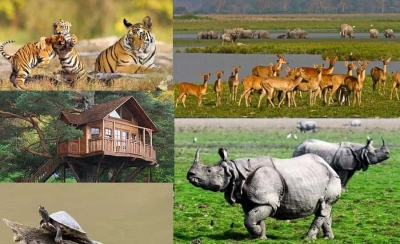
The land of the rhinoceros
1. The British connection
One of the oldest national parks in Assam, Kaziranga owes its existence to Mary Curzon and Lord Curzon, the then Viceroy of India. Back in 1904, Mary Curzon visited the area after having heard about the population of rhinos there. However, she was unable to spot a single rhino there was a sharp decline in numbers due to hunting and poaching. She persuaded Lord Curzon to take urgent measures to protect the species and the area. He obliged, and on June 1, 1907, the Kaziranga Proposed Reserve Forest was created with an area of 232 sq km. In 1908, Kaziranga was designated a ‘Reserve Forest’.
2. Find the largest population of…
The Kaziranga National Park takes credit for being home to the world’s largest population of the greater one-horned rhinoceros, wild Asiatic Buffalo and eastern, swamp deer. The rhinoceros, which has become synonymous with the park, has been hunted over the years for its horn. However, thanks to the efforts of the park, the Indian rhinoceros, which was earlier categorized as ‘endangered’, is now categorized as ‘vulnerable’ by the International Union for Conservation of Nature. According to the Union’s last assessment in December 2018, the population of the rhino is steadily increasing.
3. Did you spot a tiger?
While the park is famous because of the rhinos, it is also home to many large cats, including the tiger. Kaziranga has one of the highest densities of tigers in the world, and was declared a Tiger Reserve in 2006. It approximately has a population of 118 tigers, with a density of one per five sq km.
The park is also one of the few breeding sites outside Africa for large cats such as leopards and Bengal tigers.
4. Important bird area
Apart from mammals, one can find a variety of migratory birds, scavengers, game birds and water birds in Kaziranga. The park has been identified by Birdlife International as an Important Bird Area. Some birds such as the lesser white-fronted goose, ferruginous duck, Baer’s pochard duck and lesser adjacent migrate to the park from Central Asia during winter. Water birds in the park include Blyth’s kingfisher, white-bellied heron, and spot-billed pelican. When it comes to birds of prey, one can spot the rare eastern imperial eagle and lesser kestrel among others. The park was once home to seven species of vultures. However, the population reached near extinction due to feeding on carcasses containing the drug Diclofenac. Today, one can only find the Indian vulture, slender-billed vulture, and Indian white-rumped vulture in the park.
5. Water, water everywhere
The park is known for flooding during the monsoon season, Kaziranga experiences three seasons-summer, monsoon and winter. The monsoon, usually lasts from June to September and is responsible for most of the rainfall in the region. However, during the peak monsoon months of July and August, nearly three-fourths of the western, region of the park is submerged due to the rising water levels of the Brahmaputra River. Flooding of the park has now become common, with many animals migrating to elevated and forested regions outside the southern border of the park. The flooding has led to the death of several animals in the park over the years.
Picture Credit : Google




